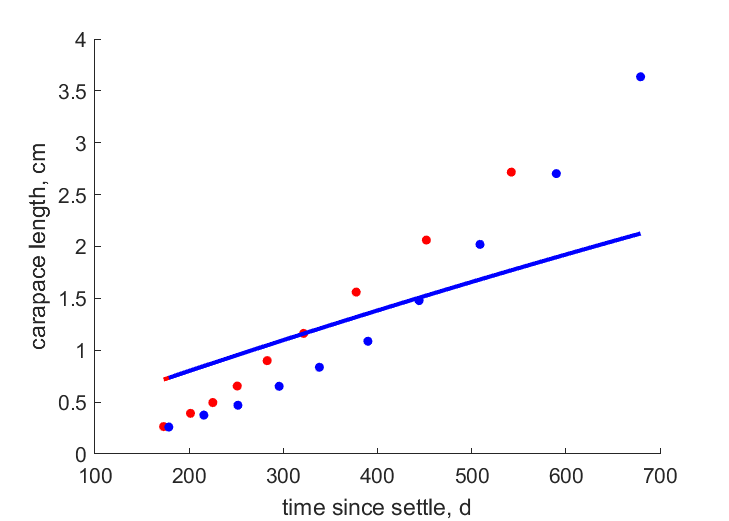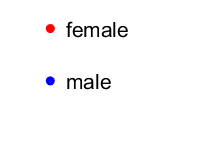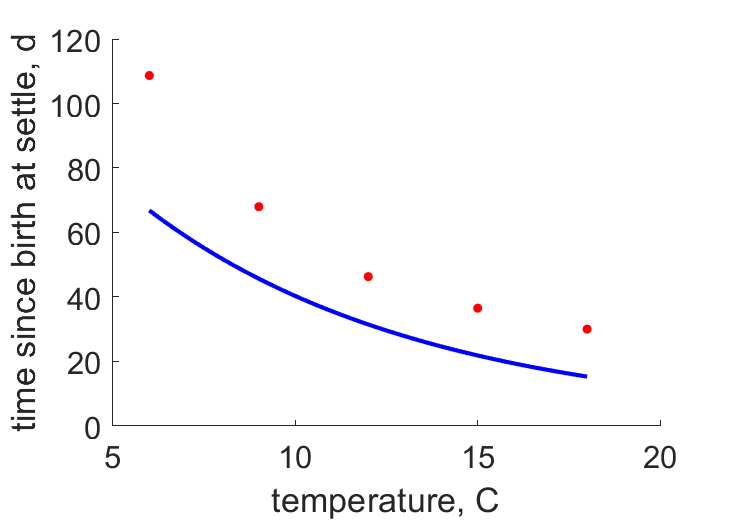Predictions & Data for this entry
| Model: abj | climate: MC | migrate: | phylum: |
| COMPLETE = 2.3 | ecozone: MANW | food: bjP, biD, jiCi, jiS | class: |
| MRE = 0.196 | habitat: 0bMcb, bjMp, jiMcb | gender: D | order: |
| SMSE = 0.094 | embryo: Mbf | reprod: O | family: |
Zero-variate data
| Data | Observed | Predicted | (RE) | Unit | Description | Reference |
|---|---|---|---|---|---|---|
| tp | 300 | 248.6 | (0.1712) | d | time since settle at puberty | HartBray2001 |
| tpm | 365 | 332.7 | (0.08841) | d | time since settle at puberty | HartBray2001 |
| am | 6935 | 6935 | (2.838e-05) | d | life span | guess |
| Lp | 0.9 | 0.8663 | (0.03744) | cm | carapace length at puberty | HartBray2001 |
| Lpm | 1.1 | 1.086 | (0.01236) | cm | carapace length at puberty | HartBray2001 |
| Lim | 6.1 | 7.292 | (0.1954) | cm | ultimate carapace length for males | Wiki |
| Wdb | 3.18e-05 | 2.532e-05 | (0.2036) | g | dry weight at birth | Ange1984 |
| Wdj | 0.000261 | 0.0002639 | (0.01096) | g | dry weight at metam | Ange1984 |
| Wwp | 0.41 | 0.2102 | (0.4873) | g | wet weight at puberty for females | HartBray2001 |
| Wwpm | 0.72 | 0.4145 | (0.4242) | g | wet weight at puberty for males | HartBray2001 |
| Wwim | 128 | 125.3 | (0.02072) | g | ultimate wet weight | Wiki, RobiGree2010 |
| Eb | 0.55 | 0.5516 | (0.002893) | J | energy content at birth | Ange1984 |
| Ej | 3.65 | 5.747 | (0.5746) | J | energy content at metam | Ange1984 |
| Ri | 23.37 | 23.39 | (0.0007526) | #/d | maximum reprod rate | guess |
Uni- and bivariate data
| Data | Figure | Independent variable | Dependent variable | (RE) | Reference |
|---|---|---|---|---|---|
| tL_f |   | time since settle | carapace length | (0.3351) | HartBray2001 |
| tL_m |   | time since settle | carapace length | (0.3842) | HartBray2001 |
| Ttj |  | temperature | time since birth at settle | (0.3747) | Ange1984 |
Pseudo-data at Tref = 20°C
| Data | Generalised animal | Hyas coarctatus | Unit | Description |
|---|---|---|---|---|
| v | 0.02 | 0.0211 | cm/d | energy conductance |
| p_M | 18 | 29.33 | J/d.cm^3 | vol-spec som maint |
| k_J | 0.002 | 0.002 | 1/d | maturity maint rate coefficient |
| k | 0.3 | 0.3001 | - | maintenance ratio |
| kap | 0.8 | 0.9762 | - | allocation fraction to soma |
| kap_G | 0.8 | 0.8083 | - | growth efficiency |
| kap_R | 0.95 | 0.95 | - | reproduction efficiency |
Discussion
- males are assumed to differ from females by E_Hp only
Facts
- length-weight: log10 (wet weight in g)= -2.843 + 2.773*log10(carapace width in mm) (Ref: RobiGree2010)
Acknowledgment
- The creation of this entry was supported by the Norwegian Science Council (NFR 255295)
Bibliography